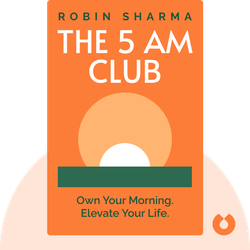Try Blinkist to get the key ideas from 7,000+ bestselling nonfiction titles and podcasts. Listen or read in just 15 minutes.
Start your free trial
Blink 3 of 8 - The 5 AM Club
by Robin Sharma

The Art, Science, and Practice of Exceptional Well-Being
Practical optimism, also known as PO, is a transformative mindset that goes beyond merely coping with stress – it’s about cultivating a deep sense of self-worth that empowers us to thrive in every aspect of life.
Sue Varma, came to PO through a personal journey. It started with a health scare that led her to explore the power of Cognitive Behavioral Therapy. Through this therapy, she not only overcame her physical symptoms but also gained tools to manage her stress effectively.
This experience ignited her quest to understand how to prevent stress from manifesting as physical illness and how to help others do the same. In short, it led her to develop the tools of practical optimism. This approach combines the resilience of traditional optimism with proactive strategies for problem-solving and personal growth.
PO isn’t just about seeing the bright side of things; it's about taking practical steps to flourish in the face of adversity. Varma outlines eight pillars – or Ps – of PO, each offering actionable strategies for improving well-being: finding your purpose; processing emotions; problem-solving; developing a healthy sense of pride, building confidence and proficiency; being present; connecting with people; and practicing healthy habits. In the sections ahead, we’ll touch on all of these pillars. But let’s first be clear about the fact that PO isn’t a fixed trait, but rather a skill that you can learn and hone. You may have heard of the term “a growth mindset.” This is what PO is all about.
So let’s start with the first of those Ps: purpose. There are common misconceptions about having a purpose, the main one being that it’s a big, important, fixed thing and that it should be tied to your career. PO emphasizes that your purpose can stem from various aspects of your life and may evolve. And, importantly, it doesn’t require outside validation.
If you’re a bit fuzzy about your own purpose, you can gain clarity through a three-step plan: Acknowledge, Identify, Move forward – or AIM, for short.
The first step involves acknowledging and reflecting on your past decisions. Ask yourself, How did I get to where I am now? Do I have any regrets? How can I put these regrets away by learning from my disappointments and using that knowledge?
Next, identify your sources of meaning and joy. Then ask yourself, How can I add more of that into my life?
The final step is to take proactive steps toward a more purposeful life that contains more of that meaning and joy. Ask yourself, Are there mentors I can reach out to?
Take these steps and celebrate when you accomplish them.
PO is more than just an outlook on life. It’s a way of building resilience and keeping your mind focused on things that provide a sense of uplift and purpose. In the next section, you’ll find out how it can help you navigate the challenges in your life more easily.



Practical Optimism (2024) offers actionable strategies for fostering well-being and resilience in everyday life. Through nurturing relationships, forming positive habits, and cultivating self-compassion, individuals can enhance their mental and physical health while thriving amidst life's challenges.
Practical Optimism (2022) by Sue Varma, M.D. explores practical strategies for fostering a positive mindset and resilience in the face of life's challenges. Here's why this book is a valuable read:
It's highly addictive to get core insights on personally relevant topics without repetition or triviality. Added to that the apps ability to suggest kindred interests opens up a foundation of knowledge.
Great app. Good selection of book summaries you can read or listen to while commuting. Instead of scrolling through your social media news feed, this is a much better way to spend your spare time in my opinion.
Life changing. The concept of being able to grasp a book's main point in such a short time truly opens multiple opportunities to grow every area of your life at a faster rate.
Great app. Addicting. Perfect for wait times, morning coffee, evening before bed. Extremely well written, thorough, easy to use.
Try Blinkist to get the key ideas from 7,000+ bestselling nonfiction titles and podcasts. Listen or read in just 15 minutes.
Start your free trial
Blink 3 of 8 - The 5 AM Club
by Robin Sharma
What is the main message of Practical Optimism?
The main message of Practical Optimism is to embrace positive thinking for a fulfilling life.
How long does it take to read Practical Optimism?
Reading Practical Optimism takes a few hours. The Blinkist summary can be read in 15 minutes.
Is Practical Optimism a good book? Is it worth reading?
Practical Optimism is worth reading for its practical advice on achieving a positive mindset.
Who is the author of Practical Optimism?
The author of Practical Optimism is Sue Varma, M.D.